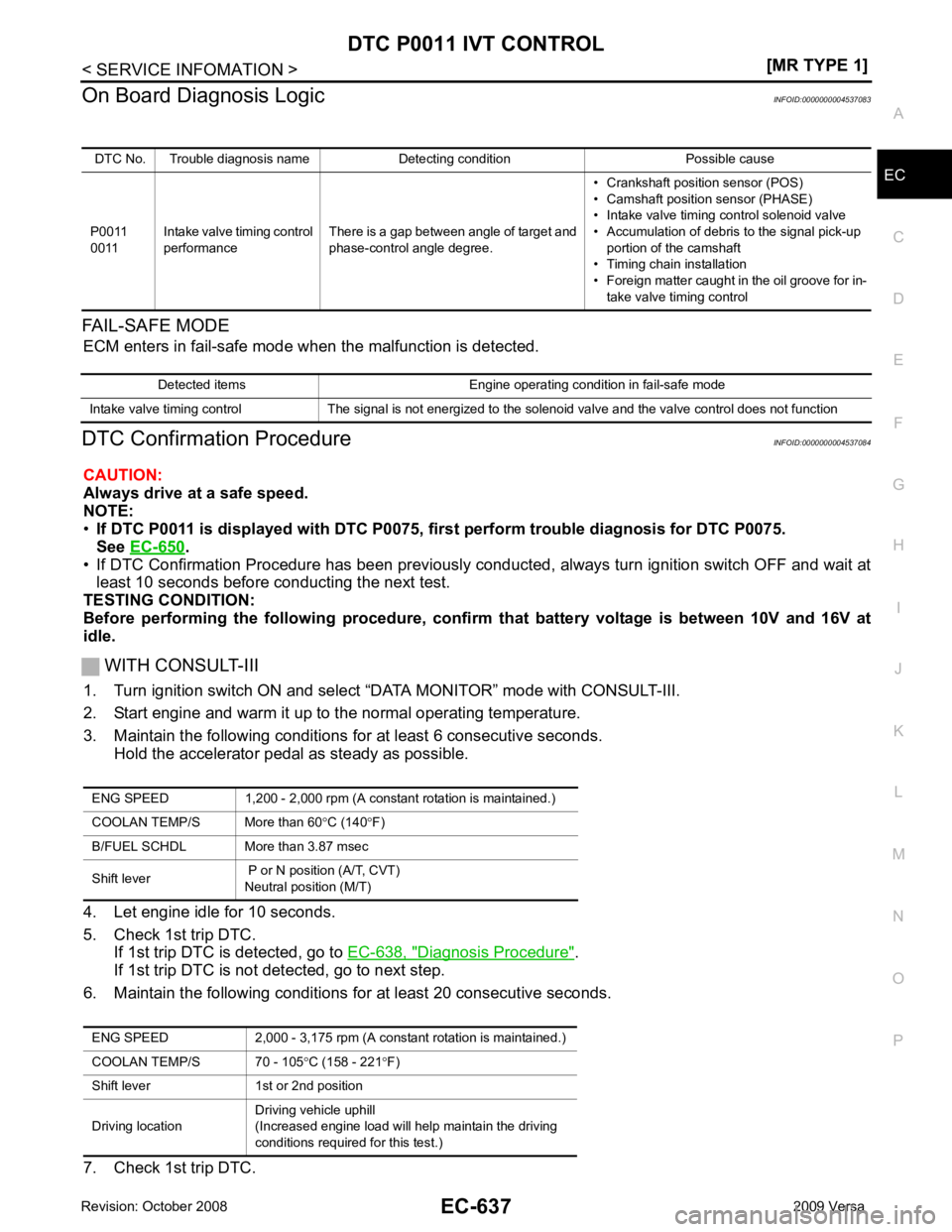2009 NISSAN LATIO turn signal
[x] Cancel search: turn signalPage 1989 of 4331

EC
NP
O
DTC U1000, U1001 CAN
COMMUNICATION LINE
Description INFOID:0000000004537072
CAN (Controller Area Network) is a serial communication li ne for real time application. It is an on-vehicle mul-
tiplex communication line with high data communication speed and excellent error detection ability. Many elec-
tronic control units are equipped onto a vehicle, and each control unit shares information and links with other
control units during operation (not independent). In CAN communication, control units are connected with 2
communication lines (CAN H line, CAN L line) allowing a high rate of information transmission with less wiring.
Each control unit transmits/receives data but selectively reads required data only.
On Board Diagnosis Logic INFOID:0000000004537073
*1: This self-diagnosis has the one trip detection logic (A/T, CVT).
The MIL will not light up for this self-diagnosis (M/T).
*2: The MIL will not light up for this self-diagnosis.
DTC Confirmation Procedure INFOID:0000000004537074
1. Turn ignition switch ON and wait at least 3 seconds.
2. Check 1st trip DTC.
3. If 1st trip DTC is detected, go to EC-634, " Diagnosis Procedure " .
DTC No.
Trouble diagnosis
name DTC detecting condition Possible cause
U1000* 1
1000* 1
CAN communication
line When ECM is not transmitting or receiving CAN
communication signal of OBD (emission related
diagnosis) for 2 seconds or more. • Harness or connectors
(CAN communication line is open or
shorted.)
U1001* 2
1001* 2 When ECM is not transmitting or receiving CAN
communication signal other than OBD (emission-
related diagnosis) for 2 seconds or more.
Page 1993 of 4331

EC
NP
O
On Board Diagnosis Logic
INFOID:0000000004537083
FAIL-SAFE MODE ECM enters in fail-safe mode w hen the malfunction is detected.
DTC Confirmation Procedure INFOID:0000000004537084
CAUTION:
Always drive at a safe speed.
NOTE:
• If DTC P0011 is displayed with DTC P0075, first perform trouble diagnosis for DTC P0075.
See EC-650 .
• If DTC Confirmation Procedure has been previously conduc ted, always turn ignition switch OFF and wait at
least 10 seconds before conducting the next test.
TESTING CONDITION:
Before performing the following procedure, confi rm that battery voltage is between 10V and 16V at
idle.
WITH CONSULT-III
1. Turn ignition switch ON and select “DATA MONITOR” mode with CONSULT-III.
2. Start engine and warm it up to the normal operating temperature.
3. Maintain the following conditions for at least 6 consecutive seconds. Hold the accelerator pedal as steady as possible.
4. Let engine idle for 10 seconds.
5. Check 1st trip DTC. If 1st trip DTC is detected, go to EC-638, " Diagnosis Procedure " .
If 1st trip DTC is not detected, go to next step.
6. Maintain the following conditions for at least 20 consecutive seconds.
7. Check 1st trip DTC. DTC No. Trouble diagnosis name Detecting condition Possible cause
P0011
0011 Intake valve timing control
performance There is a gap between angle of target and
phase-control angle degree. • Crankshaft position sensor (POS)
• Camshaft position sensor (PHASE)
• Intake valve timing control solenoid valve
• Accumulation of debris to the signal pick-up portion of the camshaft
• Timing chain installation
• Foreign matter caught in the oil groove for in- take valve timing control Detected items Engine operating condition in fail-safe mode
Intake valve timing control The signal is not energized to the solenoid valve and the valve control does not function ENG SPEED 1,200 - 2,000 rpm (A constant rotation is maintained.)
COOLAN TEMP/S More than 60 °C (140 °F)
B/FUEL SCHDL More than 3.87 msec
Shift lever P or N position (A/T, CVT)
Neutral position (M/T)
ENG SPEED 2,000 - 3,175 rpm (A constant rotation is maintained.)
COOLAN TEMP/S 70 - 105 °C (158 - 221 °F)
Shift lever 1st or 2nd position
Driving location Driving vehicle uphill
(Increased engine load will help maintain the driving
conditions required for this test.)
Page 1998 of 4331
![NISSAN LATIO 2009 Service Repair Manual EC-642< SERVICE INFOMATION >
[MR TYPE 1]
DTC P0031, P0032
A/F SENSOR 1 HEATER
Do not use ECM ground terminals when measuring in put/output voltage. Doing so may result in dam-
age to the ECMs transi NISSAN LATIO 2009 Service Repair Manual EC-642< SERVICE INFOMATION >
[MR TYPE 1]
DTC P0031, P0032
A/F SENSOR 1 HEATER
Do not use ECM ground terminals when measuring in put/output voltage. Doing so may result in dam-
age to the ECMs transi](/manual-img/5/57359/w960_57359-1997.png)
EC-642< SERVICE INFOMATION >
[MR TYPE 1]
DTC P0031, P0032
A/F SENSOR 1 HEATER
Do not use ECM ground terminals when measuring in put/output voltage. Doing so may result in dam-
age to the ECM's transistor. Use a ground ot her than ECM terminals, such as the ground.
: Average voltage for pulse signal (Actual pulse signal can be confirmed by oscilloscope.)
Diagnosis Procedure INFOID:00000000045370931.
CHECK GROUND CONNECTIONS
1. Turn ignition switch OFF.
2. Loosen and retighten ground screw on the body. Refer to EC-632, " Ground Inspection " .
OK or NG OK >> GO TO 2.
NG >> Repair or replace ground connections. 2.
CHECK AIR FUEL RATIO (A/F) SENSOR 1 POWER SUPPLY CIRCUIT
1. Disconnect air fuel ratio (A/F) sensor 1 harness connector (1).
2. Turn ignition switch ON.
- Air fuel ratio (A/F) sensor 1 (2) TERMI-
NAL
NO. WIRE
COLOR ITEM CONDITION DATA (DC Voltage)
3 G A/F sensor 1 heater [Engine is running]
• Warm-up condition
• Idle speed
(More than 140 seconds after starting
engine) Approximately 2.9 - 8.8V
49 W A/F sensor 1 [Engine is running]
• Warm-up condition
• Engine speed: 2,000 rpm Approximately 1.8V
Output voltage varies with air fuel
ratio.
53 B A/F sensor 1 [Ignition switch: ON]Approximately 2.2V PBIA8148J
:
Vehicle front
1. Body ground E24 2. Engine ground F9 3. Engine ground F16
4. Body ground E15 BBIA0698E
BBIA0699E
Page 1999 of 4331
![NISSAN LATIO 2009 Service Repair Manual DTC P0031, P0032 A/F SENSOR 1 HEATER
EC-643
< SERVICE INFOMATION >
[MR TYPE 1] C
D E
F
G H
I
J
K L
M A EC
NP
O
3. Check voltage between A/F sensor 1 terminal 4 and ground with
CONSULT-III or tester.
O NISSAN LATIO 2009 Service Repair Manual DTC P0031, P0032 A/F SENSOR 1 HEATER
EC-643
< SERVICE INFOMATION >
[MR TYPE 1] C
D E
F
G H
I
J
K L
M A EC
NP
O
3. Check voltage between A/F sensor 1 terminal 4 and ground with
CONSULT-III or tester.
O](/manual-img/5/57359/w960_57359-1998.png)
DTC P0031, P0032 A/F SENSOR 1 HEATER
EC-643
< SERVICE INFOMATION >
[MR TYPE 1] C
D E
F
G H
I
J
K L
M A EC
NP
O
3. Check voltage between A/F sensor 1 terminal 4 and ground with
CONSULT-III or tester.
OK or NG OK >> GO TO 4.
NG >> GO TO 3. 3.
DETECT MALFUNCTIONING PART
Check the following.
• Harness connectors E8, F8
• Harness for open or short between A/F sensor 1 and fuse
>> Repair or replace harness or connectors. 4.
CHECK A/F SENSOR 1 HEATER OUTPUT SIGNAL CIRCUIT
1. Turn ignition switch OFF.
2. Disconnect ECM harness connector.
3. Check harness continuity between ECM terminal 3 and A/F sensor 1 terminal 3. Refer to Wiring Diagram.
4. Also check harness for short to ground and short to power.
OK or NG OK >> GO TO 5.
NG >> Repair open circuit or short to ground or short to power in harness or connectors. 5.
CHECK A/F SENSOR 1 HEATER
Refer to EC-643, " Component Inspection " .
OK or NG OK >> GO TO 6.
NG >> Replace air fuel ratio (A/F) sensor 1. 6.
CHECK INTERMITTENT INCIDENT
Perform EC-626 .
>> INSPECTION END
Component Inspection INFOID:0000000004537094
AIR FUEL RATIO (A/F) SENSOR 1 HEATER Voltage: Battery voltage PBIB3308E
Continuity should exist.
Page 2001 of 4331

EC
NP
O
DTC P0037, P0038 HO2S2 HEATER
Description INFOID:0000000004537096
SYSTEM DESCRIPTION
The ECM performs ON/OFF control of the heated oxygen sensor 2 heater corresponding to the engine speed,
amount of intake air and engine coolant temperature.
OPERATION
CONSULT-III Reference Val ue in Data Monitor Mode INFOID:0000000004537097
Specification data are reference values.
On Board Diagnosis Logic INFOID:0000000004537098
DTC Confirmation Procedure INFOID:0000000004537099
NOTE:
If DTC Confirmation Procedure has been previously conduc ted, always turn ignition switch OFF and wait at
least 10 seconds before conducting the next test.
TESTING CONDITION:
Before performing the following procedure, confi rm that battery voltage is between 10.5V and 16V at
idle.
1. Start engine and warm it up to the normal operating temperature. Sensor Input Signal to ECM ECM Function Actuator
Camshaft position sensor (PHASE) Engine speed
Heated oxygen sensor 2
heater control Heated oxygen sensor 2 heater
Crankshaft position sensor (POS)
Engine coolant temperature sensor Engine coolant tempera-
ture
Mass air flow sensor Amount of intake air Engine speed rpm Heated oxygen sensor 2 heater
Above 3,600 OFF
• Below 3,600 rpm after the following conditions are met.
- Engine: After warming up
- Keeping the engine speed between 3,500 and 4,000 rpm for 1 minute and at idle for 1 minute under no load ONMONITOR ITEM CONDITION SPECIFICATION
HO2S2 HTR (B1) • Engine speed: Below 3,600 rpm after the following conditions are met
- Engine: After warming up
- Keeping the engine speed between 3,500 and 4,000 rpm for 1 minute and
at idle for 1 minute under no load. ON
• Engine speed: Above 3,600 rpm OFF DTC No.
Trouble diagnosis
name DTC detecting condition Possible cause
P0037
0037 Heated oxygen
sensor 2 heater
control circuit low The current amperage in the heated oxygen sensor
2 heater circuit is out of the normal range.
(An excessively low voltage signal is sent to ECM
through the heated oxygen sensor 2 heater.) • Harness or connectors
(Heated oxygen sensor 2 heater circuit is
open or shorted.)
• Heated oxygen sensor 2 heater
P0038
0038 Heated oxygen
sensor 2 heater
control circuit high The current amperage in the heated oxygen sensor
2 heater circuit is out of the normal range.
(An excessively high voltage signal is sent to ECM
through the heated oxygen sensor 2 heater.) • Harness or connectors
(Heated oxygen sensor 2 heater circuit is
shorted.)
• Heated oxygen sensor 2 heater
Page 2003 of 4331
![NISSAN LATIO 2009 Service Repair Manual DTC P0037, P0038
HO2S2 HEATER
EC-647
< SERVICE INFOMATION >
[MR TYPE 1] C
D E
F
G H
I
J
K L
M A EC
NP
O
Specification data are reference values
and are measured between each terminal and ground.
Pul NISSAN LATIO 2009 Service Repair Manual DTC P0037, P0038
HO2S2 HEATER
EC-647
< SERVICE INFOMATION >
[MR TYPE 1] C
D E
F
G H
I
J
K L
M A EC
NP
O
Specification data are reference values
and are measured between each terminal and ground.
Pul](/manual-img/5/57359/w960_57359-2002.png)
DTC P0037, P0038
HO2S2 HEATER
EC-647
< SERVICE INFOMATION >
[MR TYPE 1] C
D E
F
G H
I
J
K L
M A EC
NP
O
Specification data are reference values
and are measured between each terminal and ground.
Pulse signal is measured by CONSULT-III.
CAUTION:
Do not use ECM ground terminals wh en measuring input/output voltage. Doing so may result in dam-
age to the ECM's transistor. Use a ground ot her than ECM terminals, such as the ground.
: Average voltage for pulse signal (Actual pulse signal can be confirmed by oscilloscope.)
Diagnosis Procedure INFOID:00000000045371011.
CHECK GROUND CONNECTIONS
1. Turn ignition switch OFF.
2. Loosen and retighten ground screw on the body. Refer to EC-632, " Ground Inspection " .
OK or NG OK >> GO TO 2.TER-
MI-
NAL
NO. WIRE
COLOR ITEM CONDITION DATA (DC Voltage)
5 G Heated oxygen sensor 2
heater [Engine is running]
• Engine speed: Below 3,600 rpm after the fol- lowing conditions are met.
- Engine: After warming up
- Keeping the engine speed between 3,500 and 4,000 rpm for 1 minute and at idle for 1
minute under no load. Approximately 10V
[Ignition switch: ON]
• Engine stopped
[Engine is running]
• Engine speed: Above 3,600 rpm. BATTERY VOLTAGE
(11 - 14V)
50 W Heated oxygen sensor 2 [Engine is running]
• Revving engine from idle to 3,000 rpm quick-
ly after the following conditions are met.
- Engine: After warming up
- Keeping the engine speed between 3,500 and 4,000 rpm for 1 minute and at idle for 1
minute under no load. 0 - Approximately 1.0V
59 O Sensor ground
(Heated oxygen sensor 2) [Engine is running]
• Warm-up condition
• Idle speed Approximately 0V PBIA8148J
:
Vehicle front
1. Body ground E24 2. Engine ground F9 3. Engine ground F16
4. Body ground E15 BBIA0698E
Page 2008 of 4331
![NISSAN LATIO 2009 Service Repair Manual EC-652< SERVICE INFOMATION >
[MR TYPE 1]
DTC P0075 IVT CONTROL SOLENOID VALVE
Do not use ECM ground terminals when measuring in put/output voltage. Doing so may result in dam-
age to the ECMs transis NISSAN LATIO 2009 Service Repair Manual EC-652< SERVICE INFOMATION >
[MR TYPE 1]
DTC P0075 IVT CONTROL SOLENOID VALVE
Do not use ECM ground terminals when measuring in put/output voltage. Doing so may result in dam-
age to the ECMs transis](/manual-img/5/57359/w960_57359-2007.png)
EC-652< SERVICE INFOMATION >
[MR TYPE 1]
DTC P0075 IVT CONTROL SOLENOID VALVE
Do not use ECM ground terminals when measuring in put/output voltage. Doing so may result in dam-
age to the ECM's transistor. Use a ground ot her than ECM terminals, such as the ground.
: Average voltage for pulse signal (Actual pulse signal can be confirmed by oscilloscope.)
Diagnosis Procedure INFOID:00000000045371091.
CHECK INTAKE VALVE TIMING CONTROL SOLENOID VALVE POWER SUPPLY CIRCUIT
1. Turn ignition switch OFF.
2. Disconnect intake valve timing control solenoid valve (1) har- ness connector.
3. Turn ignition switch ON.
4. Check voltage between intake valve timing control solenoid valve terminal 1 and ground with CONSULT-III or tester.
OK or NG OK >> GO TO 3.
NG >> GO TO 2. 2.
DETECT MALFUNCTION PART
Check the following. TERMI-
NAL
NO. WIRE
COLOR ITEM CONDITION DATA (DC Voltage)
32 P ECM relay
(Self shut-off) [Engine is running]
[Ignition switch: OFF]
• For a few seconds after turning ignition switch
OFF 0 - 1.0V
[Ignition switch: OFF]
• More than a few seconds after turning ignition switch OFF BATTERY VOLTAGE
(11 - 14V)
73 P Intake valve timing control
solenoid valve [Engine is running]
• Warm-up condition
• Idle speed BATTERY VOLTAGE
(11 - 14V)
[Engine is running]
• Warm-up condition
• When revving engine up to 2,000 rpm quickly 7 - 10V
105 G Power supply for ECM [Ignition switch: ON] BATTERY VOLTAGE
(11 - 14V) PBIA4937J
PBIB3323E
Voltage: Battery voltage
SEF212S
Page 2009 of 4331
![NISSAN LATIO 2009 Service Repair Manual DTC P0075 IVT CONTROL SOLENOID VALVE
EC-653
< SERVICE INFOMATION >
[MR TYPE 1] C
D E
F
G H
I
J
K L
M A EC
NP
O
• Harness connectors E8, F8
• Harness for open or short between intake valve timing c NISSAN LATIO 2009 Service Repair Manual DTC P0075 IVT CONTROL SOLENOID VALVE
EC-653
< SERVICE INFOMATION >
[MR TYPE 1] C
D E
F
G H
I
J
K L
M A EC
NP
O
• Harness connectors E8, F8
• Harness for open or short between intake valve timing c](/manual-img/5/57359/w960_57359-2008.png)
DTC P0075 IVT CONTROL SOLENOID VALVE
EC-653
< SERVICE INFOMATION >
[MR TYPE 1] C
D E
F
G H
I
J
K L
M A EC
NP
O
• Harness connectors E8, F8
• Harness for open or short between intake valve timing control solenoid valve and IPDM E/R
>> Repair or replace harness or connectors.
3. CHECK INTAKE VALVE TIMING CONTROL SOLENO ID VALVE OUTPUT SIGNAL CIRCUIT FOR OPENAND SHORT
1. Turn ignition switch OFF.
2. Disconnect ECM harness connector.
3. Check harness continuity between ECM terminal 73 and intake valve timing control solenoid valve termi-
nal 2. Refer to Wiring Diagram.
4. Also check harness for short to ground and short to power.
OK or NG OK >> GO TO 4.
NG >> Repair open circuit or short to ground or short to power in harness or connectors. 4.
CHECK INTAKE VALVE TIMING CONTROL SOLENOID VALVE
Refer to EC-653, " Component Inspection " .
OK or NG OK >> GO TO 5.
NG >> Replace intake valve timing control solenoid valve. 5.
CHECK INTERMITTENT INCIDENT
Refer to EC-626 .
>> INSPECTION END
Component Inspection INFOID:0000000004537110
INTAKE VALVE TIMING CONTROL SOLENOID VALVE 1. Disconnect intake valve timing control solenoid valve harness connector.
2. Check resistance between intake valve timing control solenoid valve as follows.
If NG, replace intake valve timing control solenoid valve.
If OK, go to next step.
3. Remove intake valve timing control solenoid valve.
4. Provide 12V DC between intake valve timing control solenoid valve terminals and then interrupt it. Make sure that the plunger
moves as shown in the figure.
CAUTION:
Do not apply 12V DC continuously for 5 seconds or more.
Doing so may result in damage to the coil in intake valve
timing control solenoid valve.
If NG, replace intake valve timing control solenoid valve.
NOTE:
Always replace O-ring when intake valve timing control
solenoid valve is removed. Continuity should exist.
Terminal Resistance1 and 2 6.7 - 7.7 Ω [at 20 °C (68 °F)]
1 or 2 and ground ∞Ω
(Continuity should not exist.) PBIB0574E
PBIB2388E